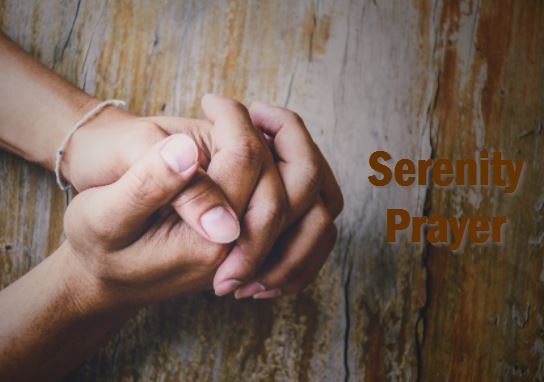Serenity Prayer : To accept the things I cannot change
Serenity Prayer | Prayer of Serenity
God grant me the serenity
to accept the things I cannot change;
courage to change the things I can;
and wisdom to know the difference.
(Although known most widely in its abbreviated form above,
the entire prayer reads as follows…)
Living one day at a time;
Enjoying one moment at a time;
Accepting hardships as the pathway to peace;
Taking, as He did, this sinful world
as it is, not as I would have it;
Trusting that He will make all things right
if I surrender to His Will;
That I may be reasonably happy in this life
and supremely happy with Him
Forever in the next.
Amen.
The Full Original Copy of the Serenity Prayer | Prayer of Serenity
by Reinhold Niebuhr (1892-1971)
God, give us grace to accept with serenity
the things that cannot be changed,
Courage to change the things
which should be changed,
and the Wisdom to distinguish
the one from the other.
Living one day at a time,
Enjoying one moment at a time,
Accepting hardship as a pathway to peace,
Taking, as Jesus did,
This sinful world as it is,
Not as I would have it,
Trusting that You will make all things right,
If I surrender to Your will,
So that I may be reasonably happy in this life,
And supremely happy with You forever in the next.
Amen.
The Serenity Prayer – What Does It Mean? | | Prayer of Serenity
The “Serenity Prayer” is one of the most well-known prayers of our time. It is the common name for a prayer originally written by theologian Reinhold Niebuhr in the late1930s to early 1940s. Research suggests that Niebuhr wrote the prayer for as part of a sermon he was giving.
While there is some controversy as to whether Niebuhr was the original author or not, Elisabeth Sifton states in her book, The Serenity Prayer, published in 2003, quotes the following version as the original serenity prayer:
“God, give us grace to accept with serenity the things that cannot be changed, courage to change the things that should be changed, and the wisdom to distinguish the one from the other.”
According to researchers, it is believed that the first version of the serenity prayer was quoted from memory in a question to The New York Times Book Review dated July 12, 1942. The query requests the name of the prayer’s author. In reply to the request, the Book Review identifies Reinhold Niebuhr as its author and quotes the prayer as follows:
“O God and Heavenly Father,
Grant to us the serenity of mind to accept that which cannot be changed; the courage to change that which can be changed, and the wisdom to know the one from the other, through Jesus Christ our Lord, Amen.”
The Serenity Prayer became much more widely known in the 1950s after it was adopted by Alcoholics Anonymous (AA). In 1950, the AA Grapevine, a popular AA magazine, also named Niebuhr as the author, and the current Alcoholics Anonymous website identifies Niebuhr as the prayer’s originator. The Serenity Prayer has also been used in Narcotics Anonymous and other Twelve-step programs.
It is interesting to note, however, that the version of the serenity prayer posted on the Alcoholics Anonymous website omits some of Niebuhr’s original text:
“God grant me the serenity to accept the things I cannot change,
courage to change the things I can,
and (the) wisdom to know the difference.”
Reinhold Niebuhr himself discusses the Serenity Prayer and how it came to be in his book, The Essential Reinhold Niebuhr: Selected Essays and Addresses. He states,
”… The embarrassment, particularly, was occasioned by the incessant correspondence about a prayer I had composed years before, which the old Federal Council of Churches had used and which later was printed on small cards to give to soldiers. Subsequently Alcoholics Anonymous adopted it as its official prayer. The prayer reads: ‘God, give us grace to accept with serenity the things that cannot be changed, courage to change the things that should be changed, and the wisdom to dintinguish the one from the other.’ …”
Finally, Reinhold Niebuhr’s daughter, Elisabeth Sifton, wrote a book about her father’s famous serenity prayer entitled, The Serenity Prayer: Faith and Politics in Times of Peace and War. In the book, Elisabeth discusses the the story and circumstances around her father’s writing of the serenity prayer, the wide range of versions of the prayer, and the true essence of the serenity prayer’s meaning.
References to the Serenity Prayer | Prayer of Serenity
The Serenity Prayer has become one of the most widely known prayers in the world. It touches peoples’ hearts from all walks of life. Below are a few references to the serenity prayer from well-known singers, songwriters, and artists.
The serenity prayer is referenced in Dan Brown’s book,”Angels & Demons.”
The back cover of the Neil Young’s album entitled “Re-ac-tor” includes the serenity prayer in Latin.
Whitney Houston’s debut album, “Whitney,” includes a reference to the serenity prayer on the rear cover.
The 70’s rock group, Boston, sings about the serenity prayer in the song, “Higher Power.”
Sinéad O’Connor, the once famous bald singer of the 90s, references the serenity prayer in her song, “Feel So Different.”
Well-known rapper, 50 Cent raps the first two lines of the serenity prayer in his song, Gotta Make It To Heaven. He says, “Lord, grant me the serenity to accept the things I can not change, the courage to change the things I can, but wisdom to know the difference.”
The soundtrack of the “Soul Food” movie addresses the serenity prayer.
Famous 60’s writer, Kurt Vonnegut, mentions the serenity prayer in his book, “Slaughterhouse Five.”
The serenity prayer has even made its way into the gaming world. In the well-known game, World of Warcraft: The Burning Crusade, one of the Blood Elves recites the serenity prayer.
In 2004, punk band Blood for Blood titled their album “Serenity,” sings a song about the serenity prayer on track 2 of their album, and the lead singer recites the serenity prayer on the first and last tracks of the album.
Finally, Olivia Newton John’s Album, Stronger Than Before, includes a song entitled “Serenity,” and references the serenity prayer within it.
Understanding the Serenity Prayer for Recovery | Prayer of Serenity
Although the Serenity Prayer is well known in recovery circles across the globe, it is still somewhat unknown to most. However, awareness of the Serenity Prayer is undoubtedly growing because it has been mentioned in many TV programmes, documentaries and films.
If you are not recovering from an addiction yourself, you may wonder what the fuss is all about.
The Serenity Prayer was written back in 1932 by an American Theologian called Reinhold Niebuhr.
The Prayer was later adopted by Alcoholics Anonymous in 1941.
Today, the Prayer has been adopted by many other 12-step organisations such as Gamblers Anonymous and Narcotics Anonymous.
The popularity of this simple prayer is owed to the deep spiritual meaning contained in its words. We shall examine each part of this short prayer below.
Defining ‘serenity’ | | Prayer of Serenity
The very word ‘serenity’ is unarguably archaic, so let’s begin by defining this term.
The online dictionary, ‘Merriam Webster’, defines the serenity as ‘calm, calmness, peace, peacefulness, placidity and tranquillity’. Thus, we feel it is fair to say that serenity is a calm state-of-mind. The antonym (opposite) of serenity is defined as ‘agitation, alarm, anguish, anxiety, anxiousness, apprehension, apprehensiveness, uneasiness, vexation and worry.’
It’s interesting to note that those trapped in the circle of drug and alcohol addiction often feel agitated, anxious and uneasy. Thus, serenity is, emotionally speaking, the polar opposite of the emotional state experienced by those who are addicted to substances or certain behaviours.
The text of the serenity prayer | Prayer of Serenity
The exact wording of the serenity prayer is as follows:
- God, grant me the serenity
- To accept the things I cannot change,
- The courage to change the things I can,
- And the wisdom to know the difference.
We shall now examine each part of the prayer below:
1. God, grant me the serenity…
As discussed above, serenity is akin to calmness. When we lack serenity, we tend to feel stressful and agitated. It’s difficult to make sensible decisions when in this negative state of mind. When we are stressed, we are likely to act impulsively and on our emotions. Doing so can have far-reaching negative consequences. Asking for serenity is a wise decision, particularly when you are about to act in a way that could result in long-term emotional or physical harm.
Stress is very much a modern disease that’s linked to a whole range of ailments such as cancer, heart disease, obesity and premature death. This backdrop means the Serenity Prayer could never be more relevant to the lives of addicts and non-addicts alike.
2. To accept the things I cannot change
Although accepting the things you cannot change is makes utter logical sense, each and every one of us is guilty of chastising ourselves or obsessing over matters that we are not in any way capable or likely to influence.
The word ‘accept’ is also significant because to accept means you are accepting the present moment without resistance of any kind. The word ‘accept’ hints at your emotional ability to bear and even accept hardship that’s not immediately within your power to change.
It’s worth mentioning that your ability to accept hardship is aided by practising mindfulness meditation because both support the goal of overcoming negativity and experiencing the present moment as a neutral observer.
Attempting to control the uncontrollable is utter madness and will, significantly, always result in either absolute failure or results that are far from ideal. To do so is an unprofitable use of your time and energy. As much as we would like to see a tropical climate in London in January, this will simply never occur.
Some of us are entirely consumed in attempting to alter things outside our control. This state of being is undoubtedly tantamount to madness. The sadness is that many of these people are not aware that they are attempting to change something that simply cannot be changed.
A classic example of this sort of maladaptive behaviour is the wish to change the behaviour of another person. In truth, it is all but impossible to compel a person to change his or her ways, no matter how hard you try.
It’s interesting to note that this part of the serenity prayer supports Step 1 of the 12 Steps where it says “We admitted we were powerless over alcohol – that our lives had become unmanageable.”
3. The courage to change the things I can | Prayer of Serenity
This sentence challenges you to examine the things in life that you can change. The magic word in this sentence is ‘can’.
One significant thing you can change is yourself. Whilst change may take a lot of effort, determination and pain, positive transformation of yourself is definitely something that is within the realms of possibility. This reasoning is highly empowering and perhaps where the power of the Serenity Prayer is most apparent.
Whilst personal change is possible, nobody said it is going to be easy. Change is usually difficult and even painful for most. Change almost always requires significant personal sacrifice in multiple areas of your life.
Lasting change also requires substantial self-determination and self-examination. Many people lack the courage to carry out a thorough self-examination because they are afraid they may not like what they find. You must also refuse to allocate blame on external factors such as events or people. Doing so will typically mean you lack the courage to change the things you are able to influence in your life.
Demanding a level of personal responsibility is about taking ownership of the things you are able to change. It’s about shifting the ‘locus of control’ inwards. Resentment towards others is one sign you are unnecessarily conceding control to outside forces.
We feel personal change means you must take radical responsibility for all aspects of your life. This includes setting boundaries of what you will and what not accept from others. Doing so means you are able to enforce matters that are within your realm of control. In time, you will truly become your own master in ways that may seem entirely alien to you given your previous record in this area.
Taking a radical level of personal responsibility has the potential to significantly alter your life’s course for the better. Altering your life’s course is not for the faint-hearted, and thus it is not surprising that the Serenity Prayer uses the word ‘courage’ in its text.
Often, changing things within your power often results in either distancing yourself from or eliminating things in your life that you cannot directly change.
4. And the wisdom to know the difference | Prayer of Serenity
For many, this last sentence of the Serenity Prayer is the most significant. Why? Because knowing the difference between what we can change and what we cannot is, in practical terms, never that straightforward. This may be because many of our decisions are driven by emotion rather than logic. This means most of us are guilty of trying to change things we are unable to change whilst neglecting the things that could actually make a difference.
Perhaps this is because, at some deep psychological level, we are afraid to implement things that we know are capable of instigating changes to how we live our lives, even if those changes are well within our best interest. The old adage is true that people are generally afraid of change.
Knowing this distinction between what we can and cannot change is often a prerequisite for enacting lasting positive change. It also allows us to focus our efforts on areas we are capable of influencing whilst allowing us to avoid wasting our precious time and energy on areas we are simply unable to change.
The word ‘wisdom’ is akin to knowledge and experience. If you have faith, you will gain this wisdom with time. Reciting the Serenity Prayer will help to instil this wisdom into your thoughts almost unconsciously. We feel the word ‘wisdom’ is interchangeable with the word ‘ability’ or ‘skill’. Thus, it may be argued the Serenity Prayer isn’t so much a prayer but more a set of instructions for successful living.
10 ways the serenity prayer helps
The Serenity Prayer: God, grant me the serenity to accept the things I cannot change; the courage to change the things I can; and the wisdom to know the difference.
- The serenity prayer is a great thing to say to yourself when you are feeling overwhelmed, angry or triggered. Reciting the serenity prayer in your head will force you to pause, when agitated, and collect yourself.
- The serenity prayer is a helpful way to remember the principles of recovery.
- The serenity prayer can help you decide whether a situation is worth getting upset over, or if it is beyond your control.
- The serenity prayer is a great reminder that we are powerless over other people, places and things.
- Reciting the serenity prayer first thing in the morning, is a great tool for starting your day on the right foot.
- The serenity prayer is even helpful to those who are unsure of what it means exactly. Reciting the serenity prayer regularly, can help a person get a better and personalized understanding of it.
- The serenity prayer can help a person develop a better relationship with their own higher power.
- The serenity prayer is helpful in learning to trust the process that you are in.
- Reciting the serenity prayer, is a selfless way to ask for help.
- The serenity prayer is helpful and applicable to nearly every situation life has to hand you.




